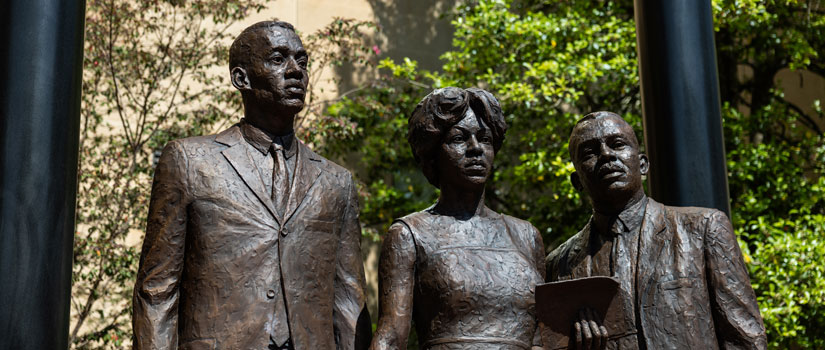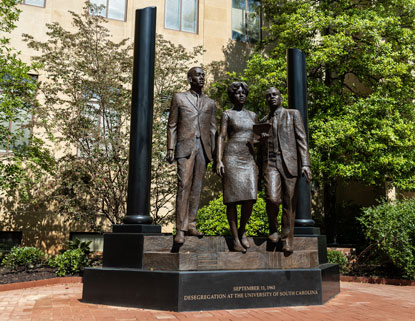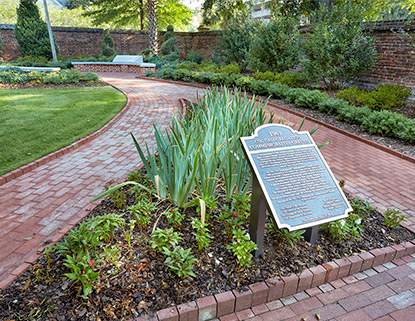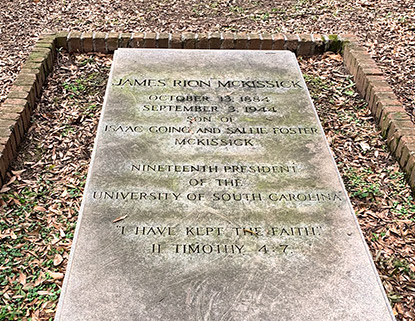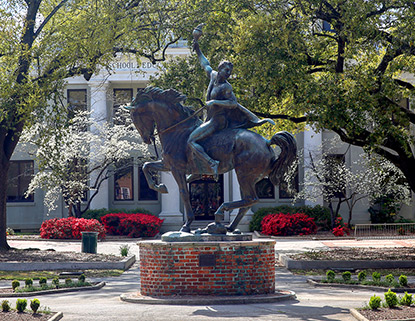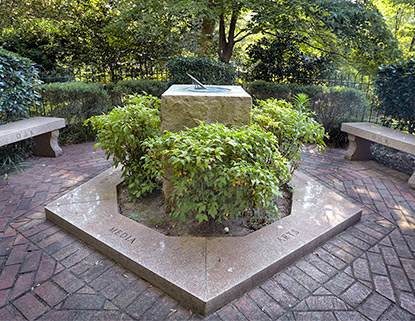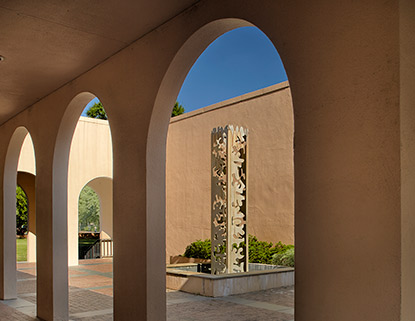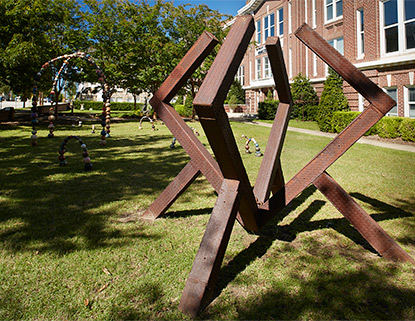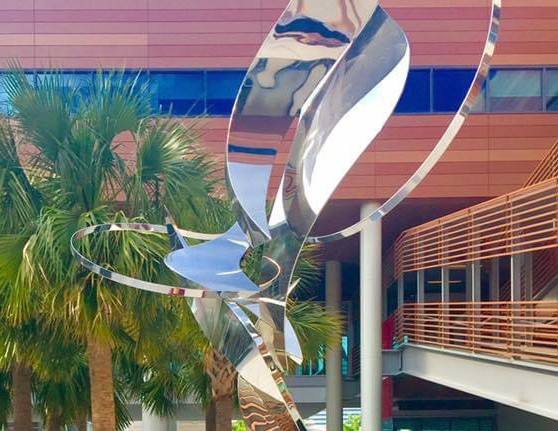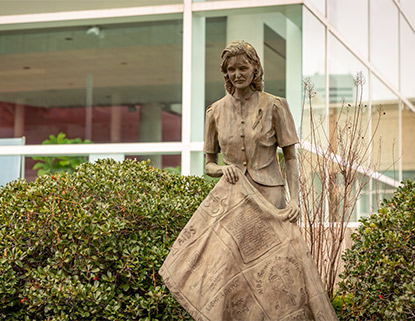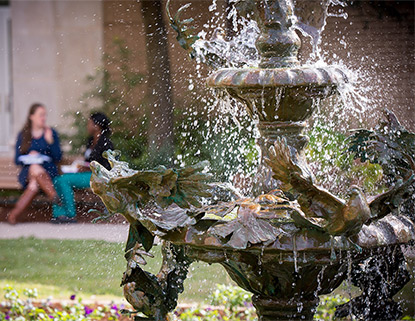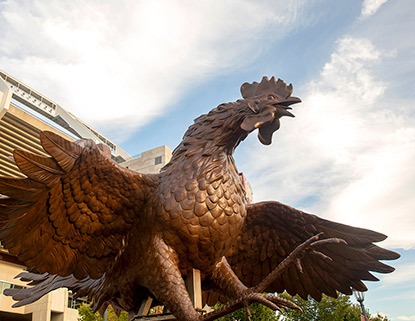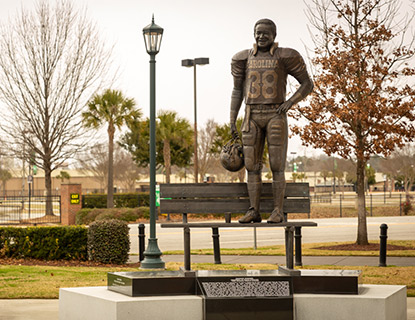Original Horseshoe Campus (1805)
One of the university's most historic areas is the Old Campus or Horseshoe. Its inclusion on the National Register of Historic places is an acknowledgment of the more than 200 years of history that have unfolded on campus, in the City of Columbia, and across South Carolina.
-
Slavery Historical Marker
Horseshoe Landmark (top of Horseshoe)
This marker acknowledges the vital contributions of enslaved people at the university during the antebellum era. Many of the historic buildings on the Horseshoe were made of slave-made brick and constructed and maintained by enslaved workers. The marker further states that: Enslaved workers were essential to the daily operations of the college, whether they were owned by the faculty or the college itself, or hired from private citizens.
-
Desegregation Monument
McKissick Museum (top of Horseshoe) | Basil B. Watson, Sculptor
This 12-foot black granite and bronze statue commemorates the post-reconstruction integration of USC. Inspired by the now-iconic photograph of three African American students — Robert G. Anderson, Henrie Monteith Treadwell and James L. Solomon Jr. — stepping out of the Osborne Administration building after meeting with university officials on Sept. 11, 1963. The artist embedded books within the steps under the three students to represent USC’s foundation of knowledge, and Treadwell holds papers signifying their passport to the university and the world of knowledge.
-
Desegregation Commemorative Garden
Horseshoe Garden (adjacent to Osborne Administration Building)
This garden honors the first three Black students admitted to the university since Reconstruction — students Henrie Monteith (now Treadwell), James L. Solomon Jr. and Robert G. Anderson who integrated the campus in 1963. The garden features three sculpted juniper topiaries created by topiary artist Pearl Fryar, flowered beds, brick pathways and a granite monument etched with an original poem written by university poet Nikky Finney. The garden was dedicated as part of a yearlong commemoration of the 50th anniversary of desegregation.
Photo by Rick Smoak Photography -
Kitchen House and Slave Quarters Marker
Horseshoe Landmark (near President's House)
This marker identifies the last remaining kitchen and slave quarters on campus — a brick building located near the southeast corner of the President’s House. Along with acknowledging the limited inclusion of these individuals in university records, the marker identifies known enslaved workers who helped build or worked at South Carolina College before the Civil War.
-
Reconstruction Historical Marker
Horseshoe Landmark (bottom of Horseshoe)
The marker recognizes the post-Civil War Reconstruction era when the state constitution mandated that education be available to all South Carolinians regardless of race. From 1873-1877, the university admitted African American students and faculty members. In 1877, the university was forcibly closed by the state legislature and reopened in 1880 as an all-white institution, remaining segregated until 1963.
-
Jonathan Maxcy Monument
Horseshoe Landmark | Robert Mills, Designer
South Carolinian Robert Mills, the nation’s first federal architect, designed the granite and marble monument that stands in the center of the Horseshoe. It was erected by the Clariosophic Literary Society in honor of South Carolina College’s first president, Jonathan Maxcy (1768-1820). Maxcy Monument is Mills’ first known use of an obelisk; his most famous one is the Washington Monument.
-
J. Rion McKissick Grave
Horseshoe Landmark (in front of South Caroliniana Library)
University of South Carolina graduate J. Rion McKissick returned to the school in 1927 as Dean of the School of Journalism and later served as university president from 1936-1944. Upon his death in 1944, the student body petitioned the board of trustees to allow McKissick to be buried on campus. He is the only person to receive that honor.
-
War Memorial Garden
Horseshoe Garden (in front of War Memorial Building)
This memorial garden honors students and alumni who died during World War I and the Mexican border dispute. The markers, originally placed in front of Davis College in 1927, share the grounds of the War Memorial Building, constructed in 1935 as the state’s memorial to those who served in World War I.
-
Richard T. Greener Statue
Next to Thomas Cooper Library | Jon Hair, Sculptor
Richard T. Greener (1844-1922) was the first African American professor at the University of South Carolina, serving during the Reconstruction Era, from 1873 through 1877. Greener was the first African American graduate of Harvard University. In addition to teaching philosophy, Latin, and Greek at USC, Greener served as librarian and helped to reorganize and catalog the library's holdings after the Civil War. After leaving South Carolina, Greener served as dean of the Howard University School of Law, as a diplomat for the United States in Vladivostok, Russia, as secretary of the Grant Memorial, and he worked in private law practice.
-
Cocky Statue
Davis College (near Melton Observatory) | Robert Allison, Sculptor
This 6-foot-5, 773-pound bronze statue of the university's popular mascot sits on a bench in the heart of campus. With one hand raised high in a spurs-up sign and the other hand resting on a stack of books, Cocky embodies the vibrant Carolina spirit and the mascot's unique role as a literacy leader around the state.
-
Torchbearer
Wardlaw College | Anna Hyatt Huntington, Artist
From its home in front of the College of Education, the cast bronze Torchbearer statue pays homage to the passing of knowledge from generation to generation. Hyatt Huntington is known for creating the first public monument by a woman in New York City outside of Central Park and founded the state's Brookgreen Gardens, a sculpture garden and wildlife preserve.
-
Sundial
Currell College
The Sundial Garden was created in honor of Omicron Delta Kappa members and alumni. Bordered by live oaks, dogwoods and boxwoods, five benches encircle the sundial in a pentagon shape.
Photo by Rick Smoak Photography
-
Longstreet Fountain
Longstreet Theater Rear Patio | Allan J. Sindler, Sculptor
Based on a design concept by Robert LaForce and interpreted in concrete in 1975 by South Carolina alumnus and sculptor Allan J. Sindler (1925-2010), the Longstreet Fountain is part of an outdoor patio at the rear of Longstreet Theater. In 2008, the fountain was reinterpreted by Sindler in stainless steel.
Photo by Rick Smoak Photography -
McMaster Sculpture Garden
McMaster College Front Lawn
McMaster College is home to the university’s School of Visual Art and Design and features an outdoor sculpture garden of student and alumni installations.
Photo by Rick Smoak Photography
-
Eternal Flame
Darla Moore School of Business Palmetto Courtyard | Leonardo Nierman, Artist
This sculpture created by Mexican artist Leonardo Nierman was the first addition of public art to the campus. Nierman’s use of flame, bird or angel symbolism conveys movement and harmony — a fitting inclusion for the nation’s top-ranked international business school.
-
AIDS Awareness Sculpture
Koger Center for the Arts | Estelle Frierson, Artist
The statue, which features a woman holding an AIDS quilt, was created by Lexington artist Estelle Frierson. The public work of art, which was presented to USC, is symbolic of the university's commitment to community outreach, education programs and research concerning HIV and AIDS.
-
Las Palomas
Arnold School of Public Health Courtyard | Sandy Scott, Artist
This bronze sculpture is the centerpiece of Anne’s Garden, named for USC alumna and Columbia Green founder Anne Rainey. The Spanish name, which name translates into “The Doves” in English, honors the doves in flight and enduring hope reflected in the sculpture composition.
-
A’ja Wilson Statue at Colonial Life Arena
Colonial Life Arena | Julie Rotblatt-Amrany, Sculptor
“Shoot for the Stars” honors the accomplishments — on and off the basketball court— of alumna A’ja Wilson, who led the Gamecocks to the 2017 NCAA National Championship, 2015 NCAA Final Four, three SEC regular-season championships and four SEC Tournament titles. The 11-foot-tall bronze statue sits atop a granite base.
-
Gamecock Statue at Williams-Brice Stadium
Springs Brooks Plaza | Jon Hair, Artist
This mammoth bronze sculpture anchors Springs Brooks Plaza and was privately funded through the generosity of alumni donors. Cast and fabricated in San Diego and transported to Williams-Brice Stadium, the statue can be found near the corner of Bluff Road and George Rogers Boulevard. It is made of over 100 individual bronze castings that are welded together.
-
George Rogers Statue at Williams-Brice Stadium
Springs Brooks Plaza | W. Stanley “Sandy” Proctor, Artist
This near-life-sized statue of alumnus, All-American and 1980 Heisman Trophy winner George Rogers depicts him standing on a bench in his number 38 jersey. Unveiled in 2015 on the day Springs Brooks Plaza was first opened to the public, the statue also features four plaques: two highlighting Rogers’ football career and records, one naming the 1980 football team roster and one listing donors of the privately funded project.
